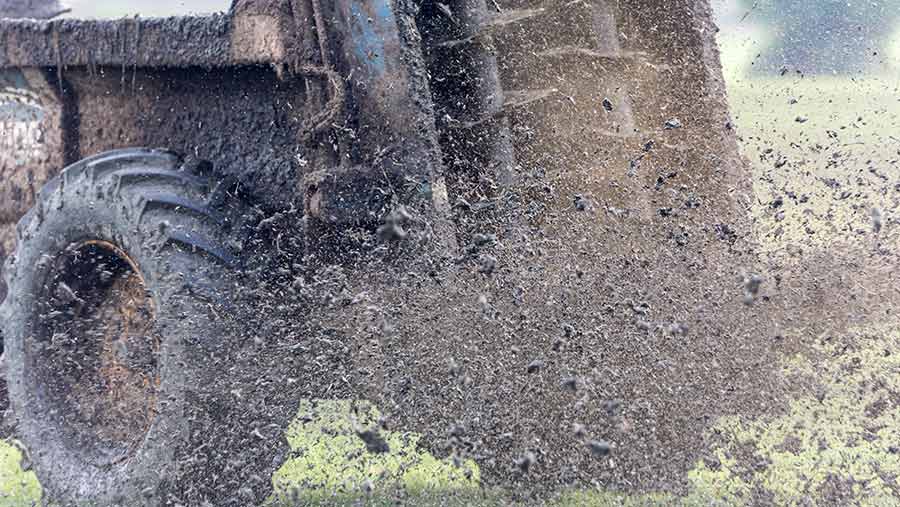New rules announced for slurry spreading during drought
 © Tim Scrivener
© Tim Scrivener The Environment Agency (EA) has introduced special measures for spreading slurry or milk in England in exceptional weather circumstances in order to minimise soil damage and water pollution during this summer’s drought.
The measures include a waiving of full storing silage, slurry and agricultural fuel oil (SSAFO) rules around temporary slurry storage as well as advice on reducing slurry production and creating contingency plans for spreading.
See also: Environment Agency steps up water abstraction inspections
The agency clarified that if spreading slurry was the only viable option for farmers and was carried out without causing pollution, it would not take enforcement action as long as certain steps were taken (see box below).
When will the EA not take enforcement action?
- If farmers contact the Environment Agency before spreading any slurry or milk on to land.
- If the EA agrees that spreading is the only option available.
- Farmers must only spread the amount of slurry and milk needed to reduce the risk of pollution.
- Spreading should be at a rate of ≤ 20 cu m/ha and on the lowest-risk land available. You may be able to export the slurry and milk to neighbouring farms.
- Farmers must carry out regular checks before, during and after spreading to ensure there is no pollution taking place.
- You are still responsible for any pollution that you cause.
Steps should also be taken reduce the amount of slurry produced during the drought including washing dairy parlours with a low- volume hose, keeping animals on straw and diverting uncontaminated surface water away from dirty yards (see list below).
Seven EA tips to reduce slurry production
- Wash dairy parlours down with a low-volume hose system (0.6 cu m per cow per month or 20 litres per cow per day).
- Remove excess dung with a brush or squeegee before hosing down to reduce the amount of wash water you need to use.
- Keep animals on straw to produce solid manure rather than slurry.
- Divert uncontaminated surface water away from dirty yards.
- Keep or move livestock on to the smallest yard area necessary.
- Install, maintain or repair gutters and downpipes, especially on roofs that drain on to dirty yards.
- Consider covering exposed fouled yard areas.
Contingency plan
Farmers need to have a contingency plan that all staff and contractors are aware of to minimise the risk of slurry or milk getting into surface water or groundwater.
The agency said slurry or milk should be stored at the place of production or use as a first option and should only be spread or disposed of at a specialised plant or stored offsite (see box below)
Hierarchy of options
- Store the slurry or milk at the place of production.
- Store the slurry or milk at the place of use.
- Dispose of the slurry or milk at an off-site anaerobic digestion plant or other effluent treatment plant, including at a sewage treatment works – milk can only go to permitted anaerobic digestion sites.
- Store the slurry or milk off site.
- Spread the slurry or milk on low run-off risk land.
Temporary slurry storage
The EA has waived full SSAFO requirements surrounding temporary slurry storage if storage will be for less than 12 months and if existing facilities become inadequate (see regulations below).
Temporary slurry store regulations
- Check planning requirements with your local planning authority.
- Contact the Environment Agency before construction.
- Agree each individual location with the Environment Agency.
- Install tanks, liners and slurry bags to manufacturer’s instructions.
- Make sure the base of earth bank lagoons is above the water table – there should be at least one metre of clay subsoil beneath the proposed base.
- Use a trial pit to confirm the depth of the clay layer – the resulting hole must be backfilled and puddled in.
- Use liners where there is doubt about soil permeability – lower-grade liners should suffice for temporary storage but use high-grade liners in high-risk areas.
- Monitor stores to make sure there are no leaks.
- Locate stores at least 10 metres from watercourses and land drains – use temporary trial trenches if you’re unsure about the presence of land drains.
- Locate stores at least 50 metres from groundwater sources.
- Decommission stores as soon as they are no longer needed.
The EA urged farmers who are unsure of the regulations to visit the Environment Agency website or call its contact centre on 03708 506 506.
